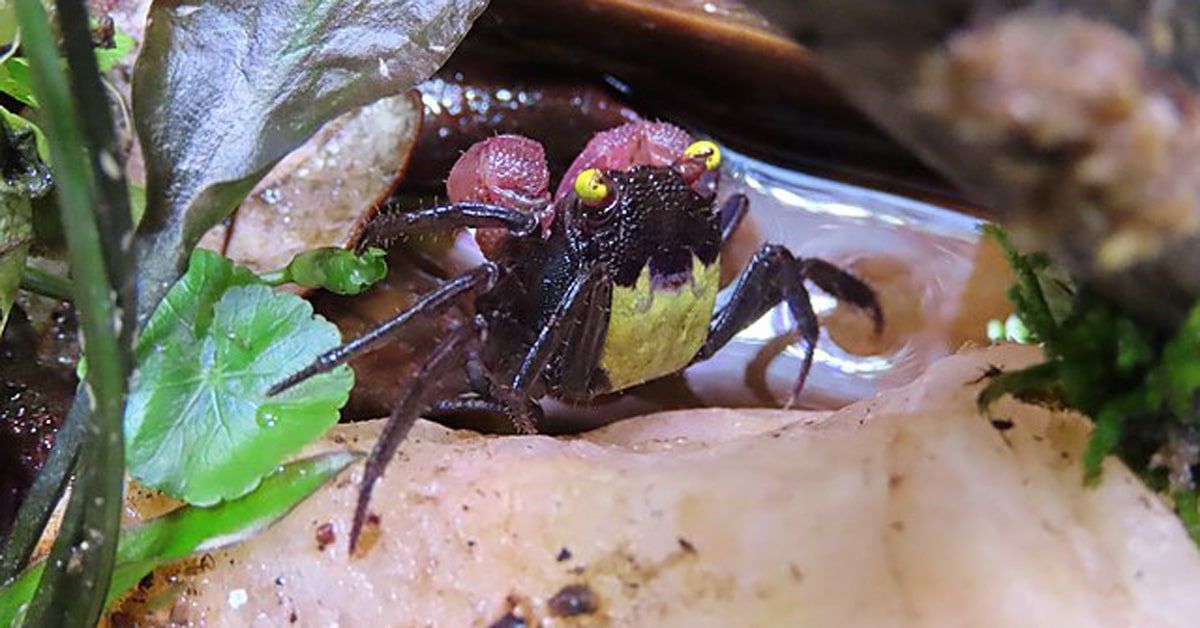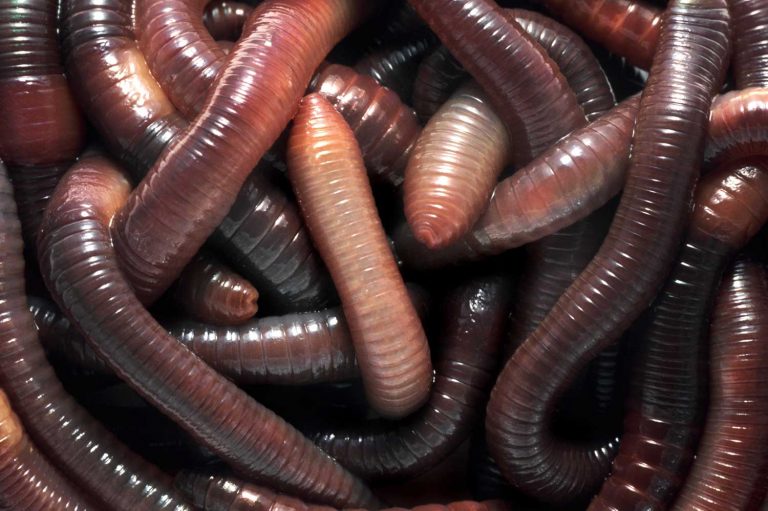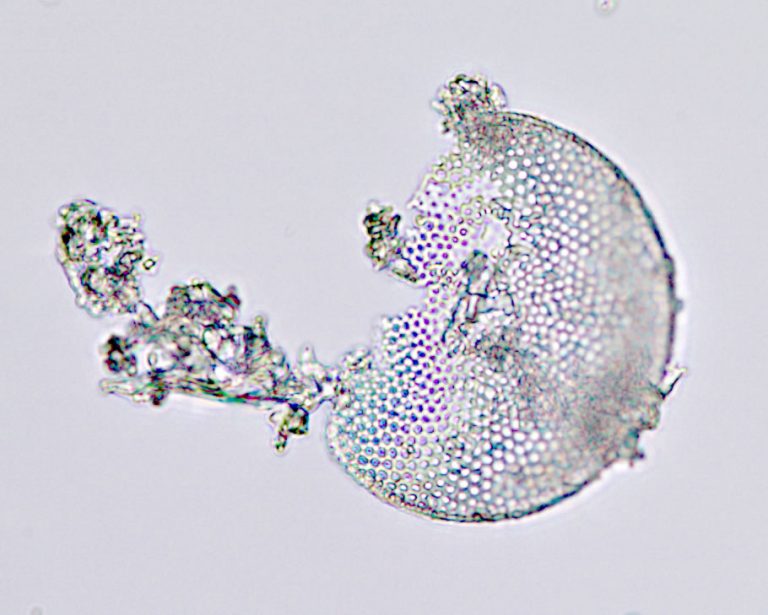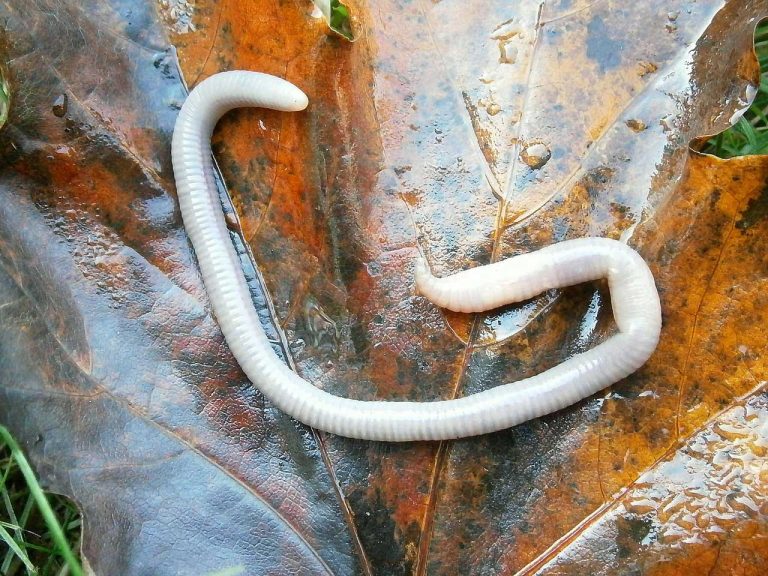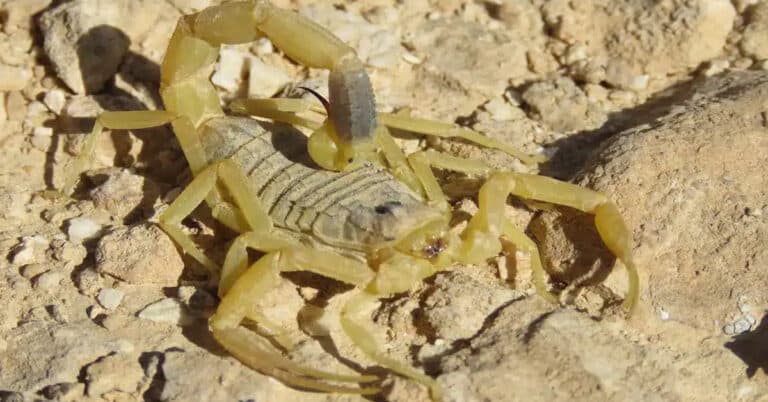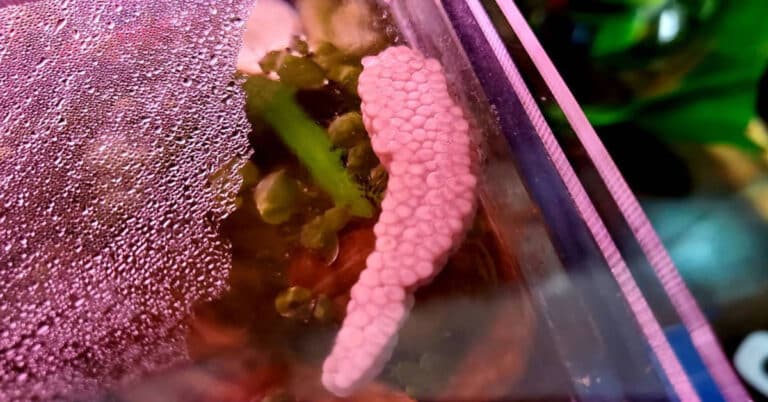Vampire Crabs – Fascinating Facts
Are you curious about the enigmatic realm of vampire crabs, enhanced with captivating colors and intricate patterns?
If so, you will be further inclined to know that the vampire crab is among the most marvelous creatures you can keep in custody. You have to meet them to believe in their distinctive colors!
However, if you’re interested in getting one for yourself, there are certain details you ought to comprehend first since each potential owner of this species needs to be aware of its particular set of specifications.
In this comprehensive guide, we will teach you everything you may have ever wondered about vampire crabs!
Origin & Lifespan of Vampire Crabs
Vampire crab originates from a small group of islands in the Indian Ocean. They have been found residing throughout Asia and the Western Pacific, including Java, Sulawesi, Riau, and Krakatau.
The Vampire Crab’s natural habitat consists of rocky caves and small tunnels dug into the soil of the valley slopes close to the edge of the freshwater stream. Vampire crabs live in shallow, warm water, where they can crawl up on roots and other tropical flora to obtain a sun break above the surface.
The average vampire crab only lives for 2 years at most. This holds true whether an animal is wild or kept in captivity. Their longevity is influenced by several circumstances, therefore, your vampire crab will thrive and live as long as possible if you provide them with high-quality water, the ideal tank setup, and an appropriate diet. Their life expectancy can be significantly reduced by illnesses brought on by an unclean environment.
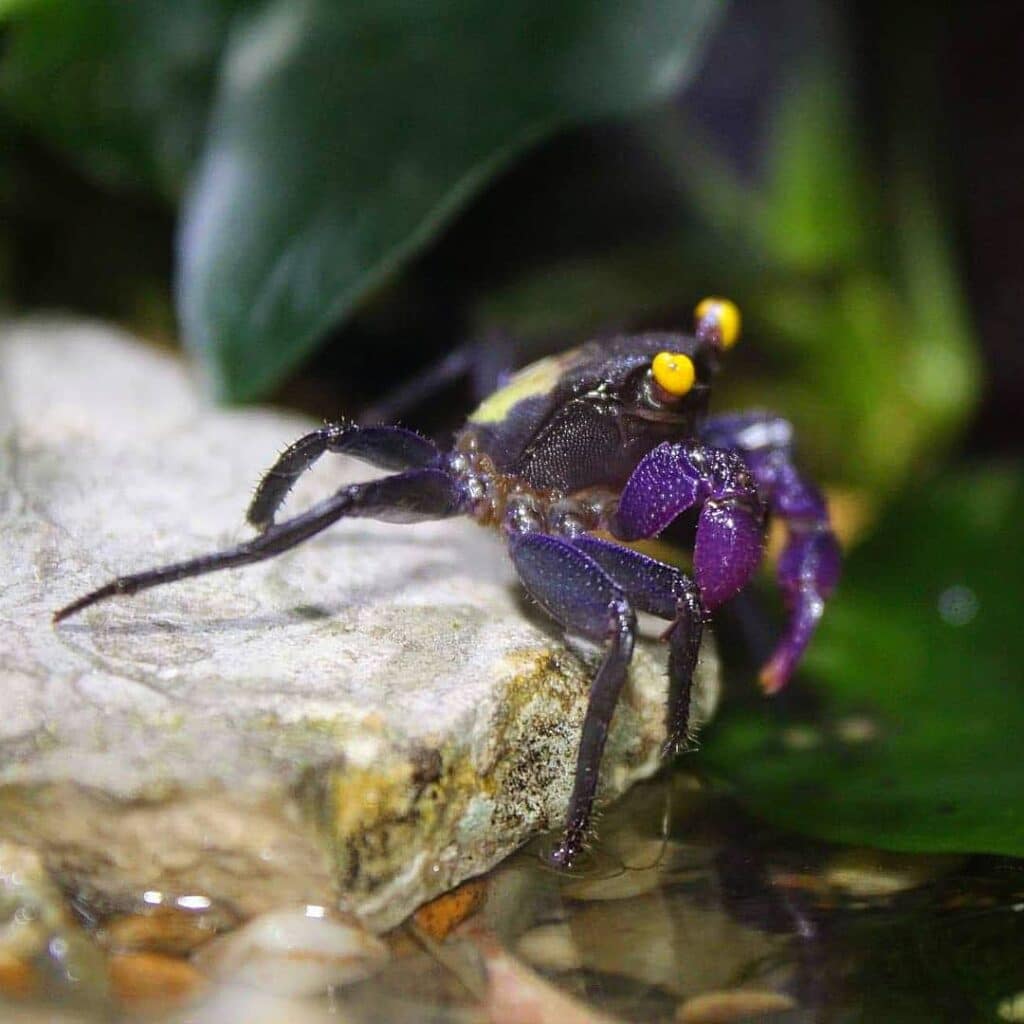
Vampire Crab Appearance: Key Characteristics & Features
Vampire crab is among the most visually appealing semi-terrestrial crab species, which is one of the factors contributing to their popularity as pets. The average size of a vampire crab is around 2 inches wide, and while their color is distinctive, their profile is comparable to that of other kinds of crabs since they have 10 legs and 2 claws.
The name “vampire crab” refers to how unsettling they look. Although certain individuals can be more of a black or brownish shade, the species is renowned for its stunning deep purple color, which is especially noticeable on the legs and claws. They are much more beautiful because of the starry-like yellowish-white markings on the back of their carapace.
Another striking characteristic of the vampire crab is its bright yellow eyes, which are located on top of stalks and create a dramatic contrast with the violet color.
Behavioral Patterns of Vampire Crab
Vampire crabs typically remain concealed during the day and come out at dusk. Do not allow vampire crabs’ occasional indolence or inability to move for hours at a time to deceive you into thinking that they are hurt or ill.
This behavioral section should emphasize that vampire crabs are not the most sociable of animals. They are notorious for being quite hostile to other crab species as well as any smaller animals like prawns or fish. However, multiple Vampire Crabs should get along just fine if you decide to adopt them.
Your crab will likely go through several molts, as all invertebrates and crustaceans do. As a young person, this happens frequently before eventually decreasing to once a month. In case they do devour it, we advise leaving the shell in the tank because it contributes to the nutrients needed to calcify their new shell. Remove it only if you don’t notice your crab engaging with it very actively.
Following molting, when they are naturally most vulnerable, vampire crabs like hiding and being quiet. Sand is preferred for tanks, which will be covered in more detail later, as newly molted animals frequently prefer to burrow into the substrate for protection and personal time.
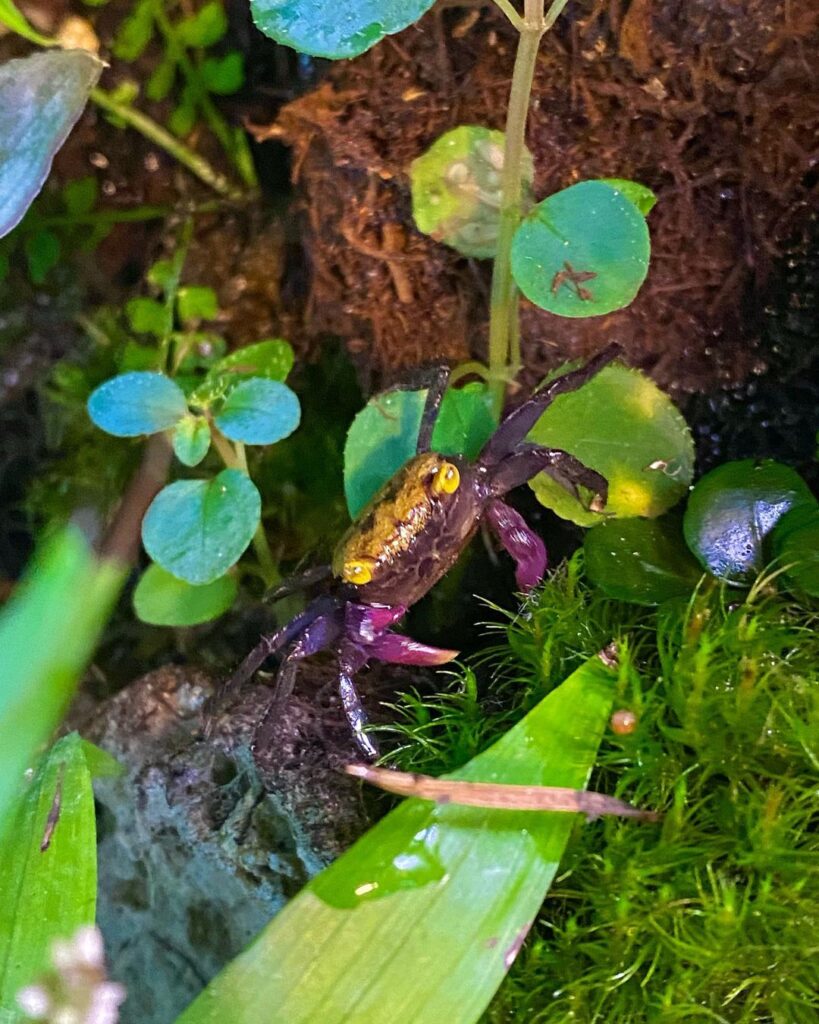
Tank Requirements for a Vampire Crab
Vampire crabs need an aquarium with a significantly lower water level, as well as decorations and plants that reach beyond the water line and lead to dry land. Aim for 80% land and only 20% water when determining the proportion of space designated for land and water.
Filtration is required to maintain the water’s cleanliness, and you should make an effort to maintain a temperature of 70 to 82 F and a pH of 7.5 to 8.0. You should replace the water at least once a month, considering these crabs are sensitive to changes in their habitat, whether they occur on land or in the water.
A tank should be at least 10 gallons in size for 1-4 vampire crabs, and you should add an extra 3-5 gallons for each additional vampire crab. However, too many crabs at once may stress them out, so wait to observe how they adapt before pushing for too many.
Since they can’t fully submerge themselves in the water, these crabs need a place where they can climb out of the water and bask in the humid atmosphere. The terrestrial section should be sandy with lots of roots, marginal/terrestrial plants, and rocky caves that serve as great hiding places for crabs after they have shed their shells.
Along with offering refuge, a way out of the water, and foraging opportunities, overgrown carpets of Java moss developed in various areas of the paludarium both in and out of the water will also be a pleasant sight. Since these crabs are excellent escape artists, a tight-fitting lid is crucial. Also, make sure to cover any openings where equipment connects to the tank.
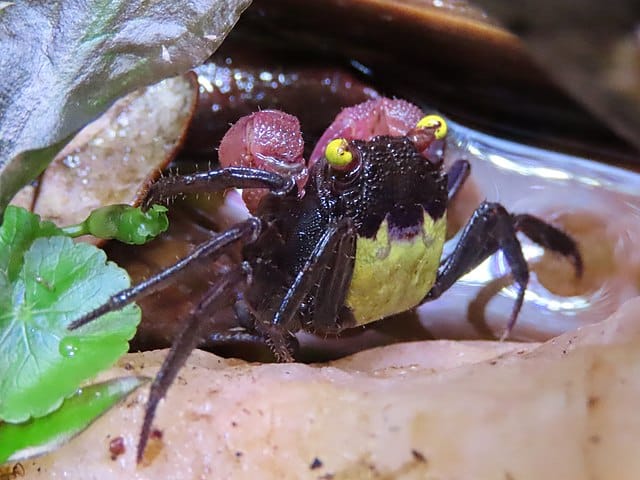
Choosing Tank Mates for Vampire Crabs
Since vampire crabs prefer to be housed in groups, they make the finest tank companions. Purple vampire crabs are friendly with their species but can be hostile to other animals, especially other crab species.
To safeguard the safety of everyone, you should be attentive while selecting your vampire crab tankmates. However, extremely small fish will probably be consumed by your crabs. Large prawns and water snails are good housemates for vampire crabs. The ideal fish to choose are those with short fins that move quickly and won’t make easy prey for your vampire crab. Cherry barbs, betta with small fins, danios, and female guppies are some excellent choices.
How to Feed Vampire Crabs
Vampire crabs are recognized as omnivorous creatures. This means that meat is a crucial source of protein for them. Therefore, you can even add things like chicken and fish to their diet. A few cuttlefish bones, which are typically found in the bird area of pet stores, should also be supplemented as calcium sources.
Bloodworms, brine shrimp, larvae, and earthworms are all delicious sources of protein. They eagerly consume grasshoppers, crickets, and plant debris. Flakes, algal wafers, and specialty pellets are also acceptable to them. The majority of things you add to a vampire crab’s tank will be enthusiastically consumed by them, but make sure there is enough variety to keep them interested in eating and prevent boredom. Broccoli, spinach, and peas are also always welcome.
To provide your crabs with a varied diet, you should feed them once a day in the ideal scenario.
Potential Health Problems
Shell damage might be a sign that a vampire crab is deficient in the minerals and nutrients needed to build a strong exoskeleton. As a crustacean, it should be strong and stable, otherwise, the specimen becomes fragile and is more likely to contract illnesses.
Maintaining a clean tank is essential to preventing bacterial and fungal illnesses, especially when it comes to water quality. You should also be aware that copper, in any form, will poison your crab, so never put them in a position where they could be exposed to it. Also, take into account that if you have vampire crabs, several chemical treatments used for fish tanks might not be a viable choice for you.
How to Breed Vampire Crabs?
When a female vampire crab reaches sexual maturity, which occurs around 6 months after birth, the male will get on top of her and fertilize her eggs, which she will then carry around for almost a month. Typically, a female vampire crab carries between 20 and 80 eggs during a breeding season.
When crabs hatch, they are completely formed, though with a little imitation of their adult selves, unlike most fish. From the start, they are highly capable and very independent when it comes to carrying out their tasks without much parental supervision. As they grow older, the young become proportionately more grounded but still spend the majority of their time in or close to the water.
The parents of newly hatched crabs should ideally be kept isolated from the adults. Otherwise, they will be eaten. Sadly, this appears to be the norm for aquatic life since there isn’t as much of a parental mentality as we usually see on land among mammals.
Conclusion
To sum up, a vampire crab is a seductive choice for individuals looking for something distinctly unique with a striking appearance — its deep purple tones combined with those hypnotic yellow eyes make it a mesmerizing addition to any tank. Even though they aren’t the most energetic or active animals in the tank, their gorgeous purple color and electrifying yellow eyes on stalks make them pretty intriguing to observe.

Nato is a content writer and researcher with a background in psychology who’s eager to explore the wonders of nature. As a travel enthusiast and animal lover, she hopes to inspire others to discover and cherish the beauty and importance of the natural world.

